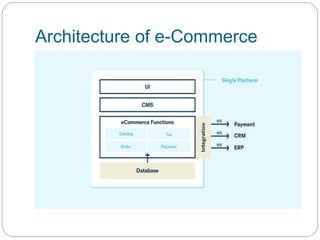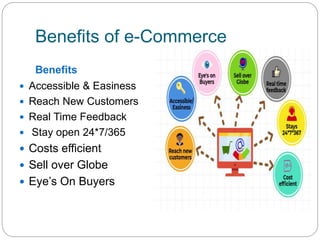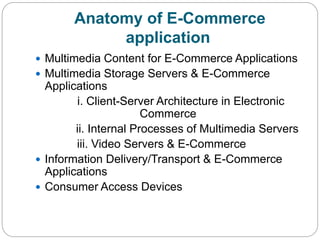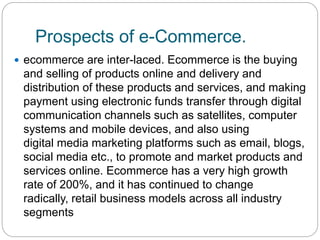Unit1 ch1
- 1. e-Commerce
- 2. Definition e-commerce (electronic commerce) is the activity of electronically buying or selling of products on online services or over the internet. Online stores like Amazon, Flipkart, Myntra etc are examples of e-commerce websites.
- 4. e-Commerce Framework e-Commerce framework is related to software frameworks for e-commerce applications. They offer an environment for building e-commerce applications quickly. e-Commerce frameworks are flexible enough to adapt them to your specific requirements. As result, they are suitable for building virtually all kinds of online shops and e- commerce related (web) applications.
- 5. e-Commerce Framework Architecture E-commerce is based on the client-server architecture . A client can be an application, which uses a Graphical User Interface (GUI) that sends request to a server for certain services . The server is the provider of the services requested by the client . In E-commerce, a client refers to a customer who requests for certain services and the server refers to the business application through which the services are provided . The business application that provides services is deployed on a Web' server.
- 7. Benefits of e-Commerce Benefits Accessible & Easiness Reach New Customers Real Time Feedback Stay open 24*7/365 Costs efficient Sell over Globe Eye’s On Buyers
- 8. Impact of e-Commerce commerce is a method for directing business over the Internet. The fact is that a moderately new idea can adjust the conventional type of economic exercises. As of now, it influences such huge parts as communications, finances, and retail transactions. It holds guarantee in zones, for example, education, wellbeing, and government. The most significant impacts might not be with a considerable set of effects that order must take into consideration. However, with the less precise yet conceivably more unavoidable notion, it can impact the routine business exercises.
- 9. Impact of e-Commerce The following are the impact of e-Commerce on the global economy. 1. Impact on Direct Marketing 2. Impact on Organization 3. Impact on Manufacturing 4. Impact on Finance 5. Impact on Supply chain management
- 10. Anatomy of E-Commerce application Multimedia Content for E-Commerce Applications Multimedia Storage Servers & E-Commerce Applications i. Client-Server Architecture in Electronic Commerce ii. Internal Processes of Multimedia Servers iii. Video Servers & E-Commerce Information Delivery/Transport & E-Commerce Applications Consumer Access Devices
- 12. e-Commerce Consumer applications Financial services and information(Home banking, financial services) Entertainment(Movies ,game etc) Essential services (Home Shopping, remote diagnostics etc) Educational and training (online course etc)
- 13. e-Commerce Organization Application Changing business Environment E-Commerce and the retail Industry Marketing and E-Commerce Inventory Management and Organizational Applications Just-in-Time (JIT) Manufacturing Quick Response Retailing (QR) Supply Chain Management
- 14. e-commerce in India India has an internet users base of about 627 million by the end of 2019 In India, cash on Delivery is the most preferred payment method, accumulating 75% of the e-retail activities. Demand for international consumer products (including long- tail items) is growing faster than in-country supply from authorized distributors and e-commerce offerings.In 2017, the largest e-commerce companies in India were Flipkart, Amazon and Snapdeal In 2018, Amazon beat Flipkart and was recorded the biggest ecommerce in india in terms of revenue
- 16. Prospects of e-Commerce. ecommerce are inter-laced. Ecommerce is the buying and selling of products online and delivery and distribution of these products and services, and making payment using electronic funds transfer through digital communication channels such as satellites, computer systems and mobile devices, and also using digital media marketing platforms such as email, blogs, social media etc., to promote and market products and services online. Ecommerce has a very high growth rate of 200%, and it has continued to change radically, retail business models across all industry segments

















